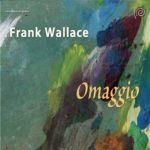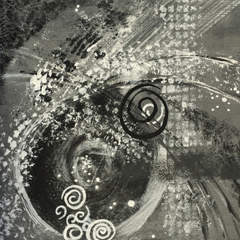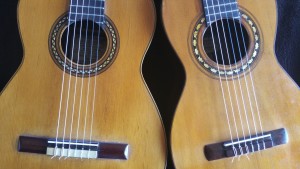WALLACE The Elements. Black Falcon. Passing in the Night. A Heavy Sleep. Sonata One Frank Wallace (gtr) GYRE (62:06)
WALLACE Gargoyles. Nocturne. The Coming of Arthur. White Albatross. Night Owl. New England Quartets Mare Duo; Anne Wolf (man); Kristina Lisner (man); Melanie Hunger (man); Thomas Kolarczyk (db) GYRE (63:19)
I would hazard a guess that unlike most other instruments, the majority of those who have composed for the guitar have also played the instrument to one degree or the other. This is due to the difficulty of writing playable music for the instrument barring some degree of knowledge of its technical capabilities. Thus, in the first disc of the two under review here, the reader is afforded the opportunity of hearing a recital of music by the composer-performer guitarist, Frank Wallace. In this case, the composer is the equal of the performer, or vice versa, and both are very good.
Because of the tuning of the instrument (normally from bottom to top, E-A-D-G-B-E), much music for this instrument is written in guitar-friendly keys, such as E Minor or D Major. The reason is simple: Music in certain keys is easier to play, and music of extended tonality or atonality is much trickier. From the very beginning of the solo CD, Wallace proves that he is not limited to the diatonic keys involving frequent use of the open strings. The first movement of the opening work, The Elements, is entitled “Fire,” and it involves some quite complex sonorities, interspersed with chords that utilize the open strings to provide a greater resonance than is achieved through stopped notes and chords. The effect is dramatic and very evocative. The movements of this suite, which also includes “Earth,” “Air,” and “Water,” are obviously derived from the four elements of the ancient Greeks, thought to be the components of all matter. Wallace uses these “elements” in a poetic fashion to depict the creation of the world–the initial explosion, the congealing of the ground, and so forth. Whether the listener would get any of this simply from hearing the piece is beside the point. The work exudes drama, and sustains interest throughout.
A Heavy Sleep draws its inspiration from the well-known Nocturnal of Benjamin Britten, by now ensconced as a staple of the guitar repertory. Commissioned on the occasion of the 100th birthday of the composer, this work evokes the Britten’s masterpiece through its textures, gestures and harmonic language. Sounds of the night are plentiful, but the work is not soporific in its effect: I stayed awake and quite interested throughout! Black Fountain, based on the octatonic scale, and a commission by guitarist Edel Muñoz, exhibits a bit more Spanish flavor in its quasi-flamenco rhythms and chords, but retains Wallace’s distinctive compositional voice.
The Bells consists of three preludes that exhibit Wallace’s experimentation in more dissonant sonorities. The latter two pieces in the set are also based upon the letters of their respective dedicatees’ names. Sonata One, on the other hand, is described by its composer as utilizing a “romantic 12-tone style.” This work was inspired by memories that the composer had of the influential LP by Julian Bream, “20th Century Guitar Music,” a disc which contained music by Britten, Smith Brindle, Martin, and Henze. Judging by the number of copies of this LP I’ve seen as a dealer, it must have sold very well, and influenced a lot of other guitarists and composers. Two virtuosic and note-rich outer movements flank a quiet “Grave” interior movement that produces much of its effect from changes in the kind of plucking of the strings that is called for. The use of different parts of the finger, or plucking closer to, or further away from the bridge of the instrument all contribute to this variety in color. The CD concludes with a moving tribute written on the passing of Wallace’s 94-year-old father, and commemorates him by depicting his love of travel, various activities, and fondly remembered sayings. The last movement, “I’m still your pappy,” includes some very non-guitar-like sounds, which must have been produced by striking various parts of the instrument.
The second CD, entitled “Gargoyles” after one of the pieces on it, combines guitar with various numbers of mandolins. If you, the purchaser of this CD, can figure out which performers on the second CD play in which pieces (Wallace himself does not play on this disc), you either have better eyes or more patience–or both–than do I. Suffice it to say that the Mare Duo, comprised of mandolinist Annika Hinsche and guitarist Fabian Hinsche, play on the majority of the works here included. Given that the mandolin is, unlike the guitar, a rather mono-chromatic instrument (most of its music consists either of plucked single lines or tremolo on notes or chords), I was not expecting to enjoy this CD as much as the solo guitar. I was quite surprised, therefore, to find myself enjoying these works every bit as much Wallace’s solo guitar works. Indeed, the range of moods and colors he extracts from the combination of guitar and mandolin(s), with occasional recourse to a double bass, is quite astonishing. The soft tremolo passages of the mandolin in the background allow the guitar to paint upon an exquisite canvas. The louder tremolos are more akin to tremolo passages in violins or other bowed string instruments, and can and do produce palpable excitement. Then, too, Wallace finds some colors on the mandolin that I had yet to encounter. In With a Wink his Dream was Changed, for instance, he calls for his mandolin performers to employ a technique that makes the mandolin sound very much like a harpsichord with the lute stop engaged, a really interesting sound. The quick juxtaposition of single plucked notes and tremolo in Night Owl was further evidence of this composer’s imagination. There was even a quick glissando in this work, something I’ve never heard on a mandolin previously.
Part of the interest in the music on this CD is the stylistic variety that the composer uses from one piece to the next, or sometimes even within the same piece. One hears everything ranging from firm tonality in Gargoyles to mysterious sonorities in White Albatross to dramatic contrasts in The Coming of Arthur. Some of the works exhibit a sort of almost Baroque counterpoint, while others use extended chordal technique to make their effect. The variety is such that my interest never flagged for a moment during the course of the CD, a fact abetted by the consummate skill of all the performers. One hears some really virtuoso playing during the course of these two CDs.
Although these two well-recorded CDs will unquestionably appeal to collectors of music on plucked instruments, I believe that their value will also be recognized by repertory collectors generally, and on that basis can give them a firm recommendation. David DeBoor Canfield
Comments
Post Date
December 11, 2014
 Omaggio
Omaggio
